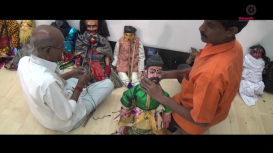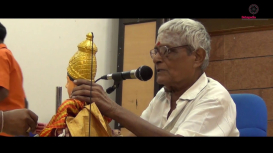The Indian subcontinent has always boasted of cultural traditions which are colourful and vibrant. These traditions, whose values have been transmitted from one generation to another, are manifested as distinct, regional representational forms. They reflect a creative artistic process which affects the thinking and living patterns of each individual in the community. Bommalattam, or puppetry in Tamil, is one of the oldest forms of story-telling; a folk form with which Indians have entertained themselves down the ages. Tamil Nadu is a popular hub of Bommalattam which is believed to have a 4000 year history. It is performed in temples during festivals and the performances last for a week to ten days, continuing past midnight. Bommalattam, narrates the traditional legends and myths such as Valli Kalyanam, Harichandra, Lava Kusa, Nallatangal Kathai and Markadeyan Kathai. In the 2nd century, the Tamil poet Thiruvalluvar made a mention of marionettes moved by strings in his Thirukkural. The mention of Pavai Koothu in the Tamil epic, Silappadhikaram by Ilago Adigal is also very significant regarding the history of puppetry. The traditional folk art form is considered as an indigenous means of communication. But today, in the age of film, television, and the internet, it is barely alive in a few regions of India. This documentation will enable the audience to ascertain the influence of Bommalattam in mainstream Tamil cinema. Veteran director, Bharathiraja, even named his film, Bommalattam, as a metaphor for real/reel life. The module is an introduction to the way puppets have been made, the cost of making them and those who still eke an existence out of the traditional art form. The project will theorize the experience of the spectator as manipulated by the director or the puppeteer. It will also bridge the gap between the academic discipline and the traditional art form through a study of Bharathiraja’s film. It will provide different perspectives, and give a well-rounded way of looking at events, situations, and people. By analyzing artworks from the past and looking at their details from a cinematic viewpoint, we gain fresh insight into the time and experience of a period different from our own. Bommalattam speculates on the central issue of the Indian metaphysical thought of the nature of the visible and the hidden. Moreover, this project provides an opportunity to acquire knowledge about traditional puppetry as well as to interact with traditional puppeteers.
Bommalattam: Performance and Performativity
in Module
Published on:
Anupama A.P. and Vinod Balakrishnan
Anupama A.P. is a research scholar at the Department of Humanities and Social Sciences, National Institute of Technology, Tiruchirapalli, working on Film Studies with a special focus on the spectatorial analysis of film. She studies the technical aspects of film from a semiotic point of view.
Vinod Balakrishnan teaches Creative Writing, Communication and Professional Ethics. He is a motivational speaker, practising poet and yoga enthusiast. He reads on Life Writing, Nation, Indian Writing in English, Cultural Representation and Humour.

